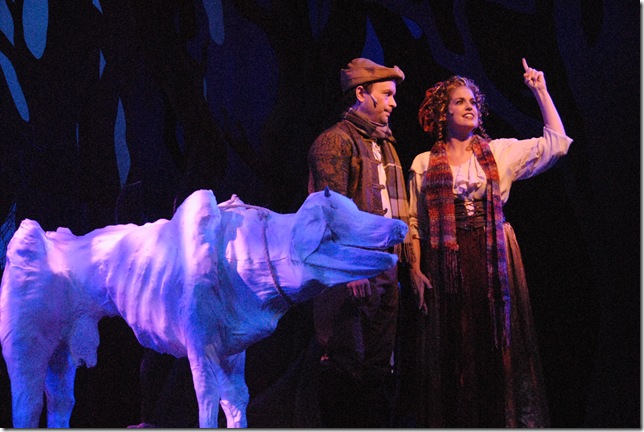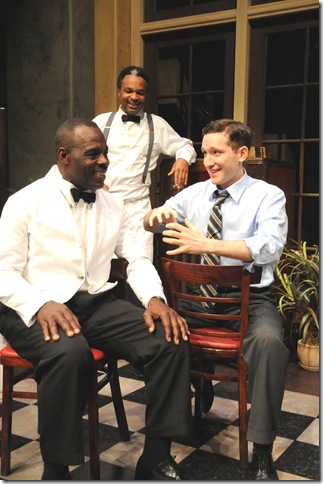Most fairy tales see the world in extremes of good and evil or right and wrong.
But leave it to Stephen Sondheim and James Lapine, in their musical constructed from intertwined fables, Into the Woods, to consider the ambiguity in these stories, asking us to look at matters from the witch’s viewpoint or the much-maligned giant’s perspective.
Is it that adult take on stories that have all too often been relegated to children that makes Into the Woods such unexpectedly sophisticated entertainment, and probably what drew Slow Burn Theatre to the material. With a cast of 19 and some two dozen intricate musical numbers, this is easily the largest undertaking for the three-year-old company, which manages to negotiate the show’s substantial demands with seeming ease.
Into the Woods shuffles several familiar tales — Cinderella, Red Riding Hood, Jack and the Beanstalk — as well as a newly devised fable about a baker and his wife, cursed by a witch yet yearning to have a child. Each of the characters wants something badly and, after attaining it by the end of the first act, following intermission the show turns darker as they learn the consequences of “happily ever after.”
Heading the cast as the Baker, who must learn a few things about marital teamwork in his quest for four objects that will erase the curse of childlessness, is co-artistic director Matthew Korinko. A reliable utility player in the past, he steps into this pivotal leading role with assurance and an authoritative 11 o’clock number, No More. He is well paired with Lisa Kerstin Braun as his spunky wife, who becomes his equal partner and then soon strays into infidelity with a royal prince.
Other standouts in the cast include Slow Burn veterans Anne Chamberlain as a sweet-voiced Cinderella (who sings the show’s concluding message song, No One Is Alone, an anthem of community) and Lindsey Forgey as a no-nonsense — yet drily comic — Red Riding Hood, a match for any hungry wolf.
Resident set designer Ian T. Almeida has outdone himself with his forest of foreboding trees that slide on, off and across the stage, creating numerous locales and playing areas. Director Patrick Fitzwater employs the physical surroundings expertly, deploying his actors without incurring traffic jams. Lance Blank provides the impressive computerized lighting and Manny Schvartzman leads a capable five-member musical combo that accompanies this heady sylvan romp, which comes recommended for Sondheads and for the Into the Woods uninitiated.
INTO THE WOODS, Slow Burn Theatre, 12811 W. Glades Road, Boca Raton. Through Sunday, April 22. Tickets: $35. Call: (866) 811-4111.
* * *
South African-born playwright Athol Fugard trusts his audience to hang in and listen carefully as he lights a purposely slow fuse, knowing that they will be rewarded for their patience with an explosive theatrical climax.
Certainly that is the case with Master Harold … and the boys, his one-act work from 1982. Fugard considers this tale of a young, white prep school student and the two black waiters at his parents’ Port Elizabeth tea shop to be his most personal play to date. In the play’s compact 90 minutes, their longtime friendship will be shattered when the boy — reacting to a family crisis — instinctively assumes the mantle of racial dominance derived from the national policy of apartheid.
It takes place on a drizzly afternoon, as Hally comes to the tea room after school, intent on doing his homework, having a snack and conversing with Willie and Sam, the two-man wait staff who have served as surrogate parents to the boy over the years. It is an ordinary day, but business is off because of the weather, allowing Sam some idle time to teach Willie a few dance moves, preparing him for an imminent ballroom competition.
Master Harold … and the boys is something of a slow dance as well, a methodical box step with seemingly benign incidents along the way — phone calls about Hally’s crippled father being discharged from the hospital, Sam wistfully recalling a time when he taught Hally to fly a kite — that accumulate into something quite combustible. Revived by Palm Beach Dramaworks as the first of a projected annual exploration of works with racial themes, the play receives a taut, well-performed production under William Hayes’s understated direction.
Master Harold is a rite-of-passage play, as Hally comes to accept his place as an adult. Embarrassment by his father’s disability and implied weakness, the boy lashes out at Sam, accepting his place in the pecking order of apartheid.
As Sam, Paul Bodie is the solid center of the production, projecting dignity and strength in a soft-spoken manner that suggests awareness and acceptance of his place in society. But when provoked, Bodie shows a steely anger that is undeniable.
Jared McGuire (Hally) capably handles the substantial verbal demands of his role, moving methodically throughout the evening from a pleasant, and somewhat naïve lad to a man of furious temper. Summer Hill Seven draws the shortest leg of the performance triangle, the often silent, somewhat slow Willie, who creeps about on the edges of the stage, but he radiates an authenticity that frequently draws attention to him.
Michael Amico’s tea room set is not the showiest design he has done for the new Don and Ann Brown Theatre, but it is another triumph of character-rich detail and atmosphere. Master Harold … and the boys is small in size and duration, but by the final curtain, as its three characters form a microcosm of South Africa’s well-earned reputation for racial inequality, Fugard demonstrates how incisive and powerful he can be tackling major issues on a simple, human scale.
MASTER HAROLD … and the boys, Palm Beach Dramaworks at the Don and Ann Brown Theatre, 201 Clematis St., West Palm Beach. Through Sunday, April 29. Tickets: $55. Call: (561) 514-4042.

